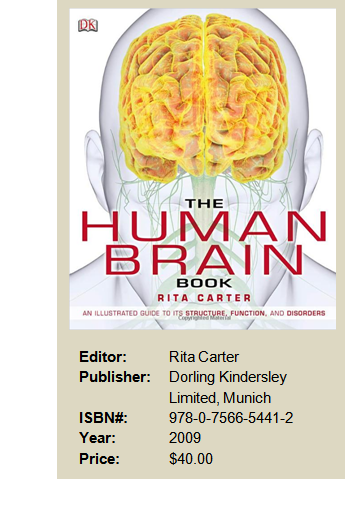 This is a beautifully illustrated guide to the human brain. Essentially designed as a student aid, this book has 256 pages of color 3-D illustrations and PET scans. An accompanying DVD-ROM allows the student to experience interactive exercises with brain scans and brain anatomy. This is a beautifully illustrated guide to the human brain. Essentially designed as a student aid, this book has 256 pages of color 3-D illustrations and PET scans. An accompanying DVD-ROM allows the student to experience interactive exercises with brain scans and brain anatomy.
The book has a table of contents, 14 sections/chapters, a glossary, an index, and a list of acknowledgments. It lacks a bibliography of further reading. Essentially laid out as illustrations with explanatory text, this book was planned as a manual for health care professionals or a neuroscience/medical reference for the family. Of particular interest is a chapter which presents 50 different brain related diseases and mental disorders with accompanying test scans and explanations.
An introductory section includes: No Ordinary Organ, Investigating the Brain, Landmarks in Neuroscience, Scanning the Brain, and A Journey through the Brain. Section 2 (The Brain and the Body) includes: Brain Functions, Nervous System, The Brain and the Nervous System, Brain Size- Energy Use- and Protection, and Evolution. Section 3 (Brain Anatomy) includes: Brain Structures, Brain Zones and Partitions, The Nuclei of the Brain, The Thalamus- Hypothalamus- and Pituitary Gland, The Brainstem and Cerebellum, The Limbic System, The Cerebral Cortex, Brain Cells, and Nerve Impulses. Section 4 (The Senses) includes: How We Sense the World, The Eye, The Visual Cortex, Visual Pathways, Visual Perception, Seeing, The Ear, Making Sense of Sound, Hearing, Smell, Perceiving Smell, Taste, Touch, The Sixth Sense [Proprioception], Pain Signals, and Experiencing Pain. Section 5 (Movement and Control) includes: Regulation, The Neuroendocrine System, Planning a Movement, Unconscious Action, and Mirror Neurons. Section 6 (Emotions and Feelings) includes: The Emotional Brain, Conscious Emotion, and Desire and Reward. Section 7 (The Social Brain) includes: Sex-Love-and Survival, Expression, The Self and Others, and The Moral Brain. Section 8 (Language and Communication) includes: Gestures and Body Language, The Origins of Language, The Language Areas, A Conversation, and Reading and Writing. Section 9 (Memory) includes: The Principles of Memory, The Memory Web, Laying down a Memory, Recall and Recognition, and Unusual Memory. Section 10 (Thinking) includes: Intelligence, Creativity and Humor, Belief and Superstition, and Cognitive Illusions. Section 11 (Consciousness) includes: What is Consciousness, Locating Consciousness, Attention and Consciousness, Altering Consciousness, Sleep and Dreams, Time, and The Self and Consciousness. Section 12 (The Individual Brain) includes: Nature and Nurture, Influencing the Brain, Personality, and Strange Brains. Section 13 (Development and Aging) includes: The Developing Brain, The Aging Brain, and The Brain of the Future. Section 14 (Diseases and Disorders) includes: The Disordered Brain, and Directory of Disorders. Clear, concise language adds to this book’s usability.
|
